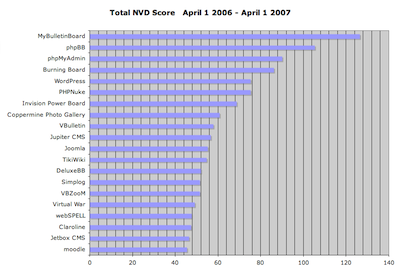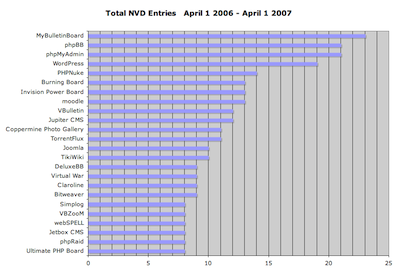Posts tagged application-security
Page Content
Thoughts on Virtualization, Security and Singularity
The “VMM Detection Myths and Realities” paper has been heavily reported and discussed before. It considers whether a theoretical piece of software could detect if it is running inside a Virtual Machine Monitor (VMM). An undetectable VMM would be “transparent”. Many arguments are made against the practicality or the commercial viability of a VMM that could provide performance, stealth and reproducible, consistent timings. The arguments are interesting and reasonably convincing that it is currently infeasible to absolutely guarantee undetectability.
However, I note that the authors are arguing from essentially the same position as atheists arguing that there is no God. They argue that the existence of a fully transparent VMM is unlikely, impractical or would require an absurd amount of resources, both physical and in software development efforts. This is reasonable because the VMM has to fail only once in preventing detection and there are many ways in which it can fail, and preventing each kind of detection is complex. However, this is not an hermetic, formal proof that it is impossible and cannot exist; a new breakthrough technology or an “alien science-fiction” god-like technology might make it possible.
Then the authors argue that with the spread of virtualization, it will become a moot point for malware to try to detect if it is running inside a virtual machine. One might be tempted to remark, doesn’t this argument also work in the other way, making it a moot point for an operating system or a security tool to try to detect if it is running inside a malicious VMM?
McAfee’s “secure virtualization”
The security seminar by George Heron answers some of the questions I was asking at last year’s VMworld conference, and elaborates on what I had in mind then. The idea is to integrate security functions within the virtual machine monitor. Malware nowadays prevents the installation of security tools and interferes with them as much as possible. If malware is successfully confined inside a virtual machine, and the security tools are operating from outside that scope, this could make it impossible for an attacker to disable security tools. I really like that idea.
The security tools could reasonably expect to run directly on the hardware or with an unvirtualized host OS. Because of this, VMM detection isn’t a moot point for the defender. However, the presentation did not discuss whether the McAfee security suite would attempt to detect if the VMM itself had been virtualized by an attacker. Also, would it be possible to detect a “bad” VMM if the McAfee security tools themselves run inside a virtualized environment on top of the “good” VMM? Perhaps it would need more hooks into the VMM to do this. Many, in fact, to attempt to catch any of all the possible ways in which a malicious VMM can fail to hide itself properly. What is the cost of all these detection attempts, which must be executed regularly? Aren’t they prohibitive, therefore making strong malicious VMM detection impractical? In the end, I believe this may be yet another race depending on how much effort each side is willing to put into cloaking and detection. Practical detection is almost as hard as practical hiding, and the detection cost has to be paid everywhere on every machine, all the time.
Which Singularity?
Microsoft’s Singularity project attempts to create an OS and execution environment that is secure by design and simpler. What strikes me is how it resembles the “white list” approach I’ve been talking about. “Singularity” is about constructing secure systems with statements (“manifests”) in a provable manner. It states what processes do and what may happen, instead of focusing on what must not happen.
Last year I thought that virtualization and security could provide a revolution; now I think it’s more of the same “keep building defective systems and defend them vigorously”, just somewhat stronger. Even if I find the name somewhat arrogant, “Singularity” suggests a future for security that is more attractive and fundamentally stable than yet another arms race. In the meantime, though, “secure virtualization” should help, and expect lots of marketing about it.
The PHP App Insecurity Top 20
I’ve spent some of my down time in the past couple weeks working with the NIST NVD data to get stats on PHP application vulnerabilities. What follows is a breakdown of the 20 PHP-based applications that had the highest aggregate vulnerability scores (NIST assigns a score from 1-10 for the severity of each entry), and the highest total number of vulnerabilities, over the past 12 months. Of the two, I feel that the aggregate score is a better indicator of security issues.
A few caveats:
- The data here covers the period between April 1 2006 and April 1 2007.
- This obviously only includes reported vulnerabilities. There are surely a lot more applications that are very insecure, but for one reason or another haven’t had as many reports.
- I chose 20 as the cutoff mainly for the sake of making the data a little easier to swallow (and chart nicely). There are about 1,800 distinct apps in the NIST NVD that are (as far as I could determine) PHP-based.
Without further ado, here are the tepid Excel charts:
A couple notes:
- There are 25 entries in the top “20” by vulnerability count, due to matching vulnerability counts.
- I’d never even heard of MyBulletinBoard, the top entry in both lists. It hasn’t had any vulnerabilities in the NVD since September of 2006, which says something about how numerous and severe the entries between April and September 2006 were. This appears to be the same product as “MyBB,” so perhaps the situation has improved, as MyBB only has one NVD entry in the entire period (CVE-2007-0544).
- Wordpress has had a bad start to 2007, with numerous vulnerabilities that significantly increased its ranking. March 2007 was particularly bad, with 7 new vulnerabilities reported.
- Bulletin board/forum software is by far the most common type of application in the top 20. A couple forum apps that have very low numbers of vulnerability reports: Vanilla and FUDForum.
I do intend to keep this data up-to-date if people find it interesting, so let me know if you’d like me to do so, or if you’d like to see other types of analysis.
[tags]php, security, application security, vulnerabilities, nist, nvd, statistics[/tags]



